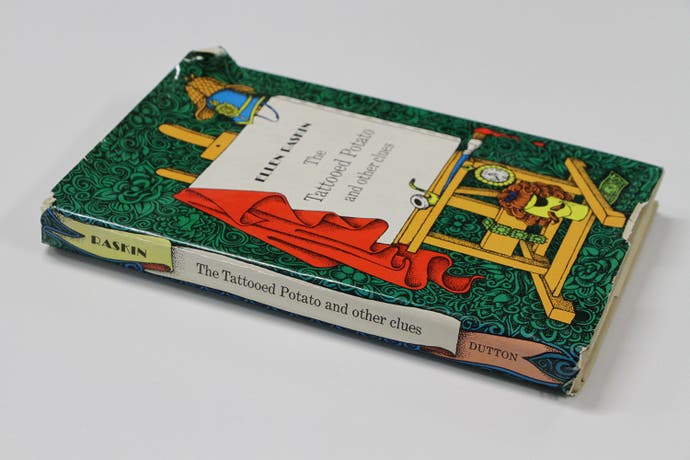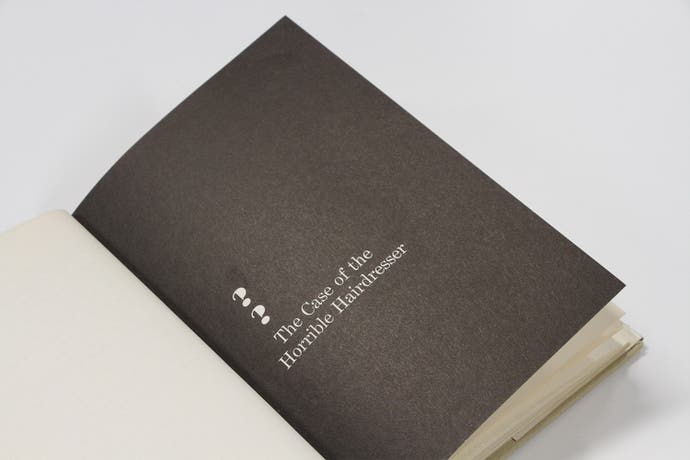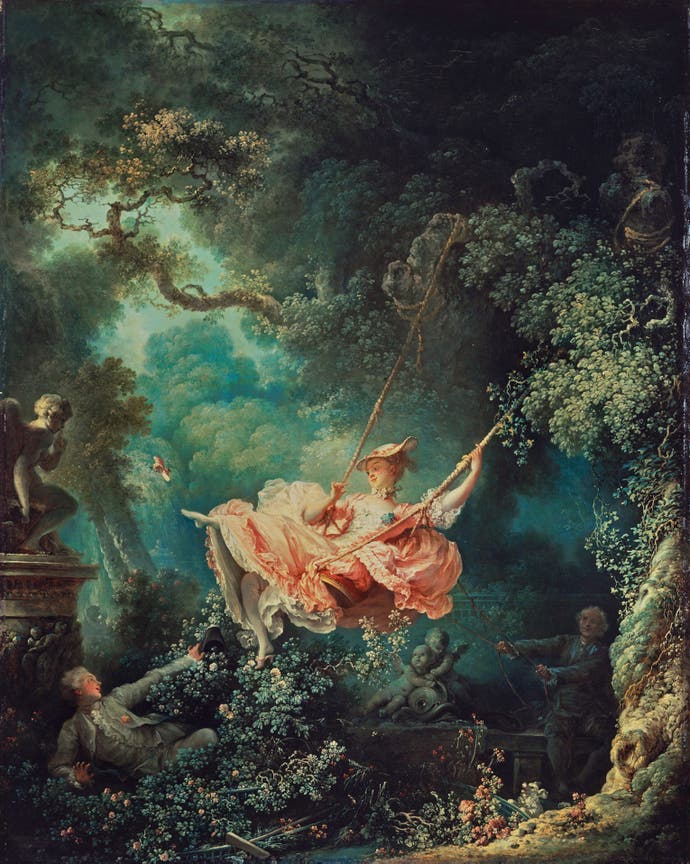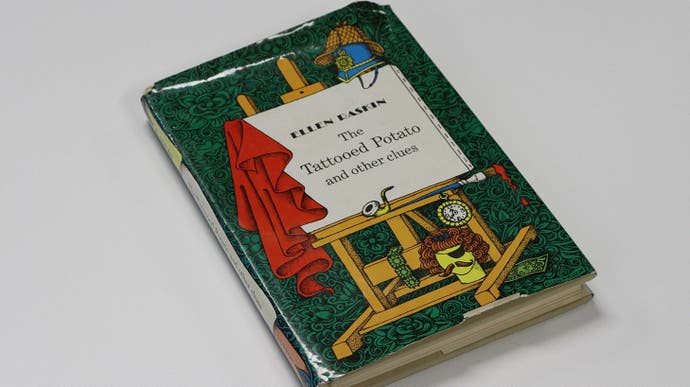Something solid in a world of liars: The Tattooed Potato and the most haunted address in New York City
The wizard near Waverly Place.
Hello! Welcome to the second installment of our new semi-regular series in which we'll be looking at world-building, the art of creating interesting settings, and, where possible, talking to the people who do this stuff for a living.
Games have a rare power to take us to new places, but they share world-building with many other art forms and disciplines. Alongside video games, we're also going to be investigating books and films and architecture and anything else that seems worth exploring.
Today, we're looking at one of Ellen Raskin's brilliant puzzle-mystery books, a classical tale of deception and intrigue with an evocative Greenwich Village setting.
(The first piece in this series, which looks at Michael Marshall Smith's wonderful novel Only Forward, can be found here.)
The Tattooed Potato and Other Clues, by Ellen Raskin
We all have stories we tell ourselves about ourselves that turn out to be wrong. They aren't always lies as such; they can be misrememberings, misperceptions, patter that ends up with the weight resting in the wrong places. For years, I put my ardent, but entirely unfocused, fascination with art down to the fact that my mum did an OU course in art history when I was nine or ten. I can remember the house filling up with glossy prints of works by Van Eyck, who I still love, and Delacroix, who I am only just now getting a taste for. I can remember the course numbers, like A101. I can remember looking at the booklets that came through the post with strange names: Modern Art and Modernism. What could that mean?
I still think that course changed my mum's life and had a massive impact on mine. But I no longer think it's where my love of art began. My love of art, I've realised quite recently, came from a book I borrowed from the school library when I was eight or so. I borrowed it because I was bored one day and the book had a funny title: The Tattooed Potato and Other Clues. The "Other Clues" part suggested a mystery story, and the book delivers on this by offering several nested mysteries that slowly reveal a much bigger, and much more unsettling, plot.
But there's so much more, too. I forgot the book for decades - or rather I forgot its position as the origin point of a lot of different things that I can never forget - but when I discovered it again a few years back, I was astounded by how rich it was. It gave me my love of art, and I'm going to inevitably talk a bit about that today. But this is a column on world-building, and what I really want to talk about is how this strange, intricate children's novel builds one of the most interesting worlds I have ever read my way into.

The Tattooed Potato is the third novel by Ellen Raskin, who's justly famous in the US but is pleasantly obscure over her - the best of both worlds, somehow. Raskin started out as an illustrator, I gather, before spreading into children's picture books and, eventually, four children's novels she called puzzle-mysteries. I've written about her before for Eurogamer because of the puzzle bit. Her books feel gamelike, even if you would struggle to actually play them. It's more that they seem to exist inside the sort of possibility space that games open up, and, as the author, she finds a role for herself that is somewhere between being a designer and a dungeon master. (Something else in the mix here too: my own daughter, who's five, has only just started watching films, and while the action often scares her and the scenes often bore her, she is fascinated by how the stories work. As we watch Home Alone together, she points out the moments where the plot is setting things up and foreshadowing stuff. Her instinctive word for these moments are "clues". Kevin has a separate plane ticket to the rest of the family: "That's a clue!")
I don't want to spoil too much of The Tattooed Potato. I want you to track it down and read it, and then I want you to ponder, as I have started to do, what an excellent basis it would make for a Netflix TV show. Anyway, let's just say it's about a young art student in New York in the 1970s. Her name is Dickory Dock and she is poor and "haunted" by a tragic past. She takes a mysterious job working for an artist who lives in a townhouse in Greenwich Village. The artist, Garson, has secrets, and so does everyone else in his orbit. Garson also has a new line of work: besides painting slick and "phony" society portraits for rich idiots, he has just started looking into cases for the chief of police, because, he argues, only a portrait painter can reliably see through a criminal's disguise.
There are a bunch of things here that make The Tattooed Potato interesting from a world-building perspective. Centrally, it makes me wonder about what world-building actually is, and how far into the depths of a work it reaches. Raskin's book is filled with references to Sherlock Holmes, so in one way, its world-building is tied into reverence, and a gentle unpicking, of an established literary template. But it's also uniquely focused on a single location, Garson's Greenwich Village house where so much of the action unfolds. And on top of that it's a book in which almost everyone is a liar - more specifically, and to return to the thought at the start of this piece, everyone seems to tell a story about themselves which is not true. This sense of duplicity, of veils and mysteries and disguises and clues, is as much a part of the world-building as the house is.
But let's start with the house. Garson lives at 12 Cobble Lane, which sounds like a very unlikely address for New York City. Back when I read the book as an eight-year-old, my idea of New York was of a magically boundless ultra-modern city in which everyone lived in skyscrapers and got Chinese takeaway all the time in neat little cartons. I couldn't understand why the book spent so much time on a location which sounded like it belonged in The Archers rather than Ghostbusters. Cobble Lane? Greenwich Village?

But I was in no confusion about the house itself, because Raskin makes it such a central character, from its facade, greeting the quiet, narrow street it sits in with blue-green shutters and a few steps up to the front door, to its interior, with a first-floor apartment where some sinister men seem to hang out, and a suite above that where Garson lives and works, enjoying a huge airy studio lit by a giant skylight.
I know this place intimately. I have lived with this book consciously and unconsciously for years. And yet it's only when I try to draw a map of the place I realise that I can't. I know that there's the first floor apartment - which means ground floor to us; it would be the floor you enter on - that's leased to mysterious baddies. And I know the entrance hallway has a staircase that Dickory often races up to avoid the baddies as she heads to Garson's studio. But there's also a cellar somewhere below all that, and a mysterious room where another mysterious occupant lives, and a furnace room and a second door out to the street that I can't seem to make work in my mind. And then there's Garson's apartment which has this huge studio, but also other rooms such as a bedroom and a kitchen, and the studio itself has another storey because it has a balcony that runs above it. An internal balcony? How to fit this all together.
In truth, I just go with it. Each part of the house is described clearly. As a reader, you always know the things you need to know. You know the way that the creeps on the first floor peer through their half-opened door when Dickory comes in each day. You know that Garson bangs on a radiator with a hammer when he wants that mysterious person in his own mysterious room to come up and do something for him. And you know that at the centre of Garson's studio, beneath the skylight, there are two easels set up, one for the slick art that Garson rattles off for his idiots, and another for a messy artist whose identity is unknown, and whose work is unknown too, as it's always covered with a red drape.
I marvel at this now: a world that's precisely described but also filled - to me at least - with these gaps that I only notice when I'm actually really looking for them. It was only when I tried to sketch the layout of the house that I realised I couldn't. And yet this slight internal confusion that I feel about the layout doesn't make the world-building fall apart. In truth, it makes it so much stronger. I realise now when, every time I read the book, having always forgotten how the complex plot comes together at the end, I always suspect that things are going to hinge on a room that's waiting somewhere to be uncovered. (Spoiler: It doesn't.) I think this is because of the architectural uncertainty that is secretly built into the place - and I think it's done with such elegant secrecy because the descriptive sections seem so plain and honest and uncomplicated.
The other thing I always think is that the house is going to turn out to be a metaphor for the book itself. And again, as far as I currently understand things, having read the book for the nth time this week, the eventual conclusion is so much better than that. Gappy as it is, the house is actually there to shore up the novel, I think. Rather than echo theme, it is there to support it in a surprisingly tangible way, to make what could, at first, be a playful confection of a novel feel real. 12 Cobble Lane feels so solid - despite its silent internal jumbling - because nothing else in the book is. Everyone who goes into 12 Cobble Lane is telling lies. (Everyone except Dickory, who walks in her own personal world of misperceptions and half-perceptions.)

Enter art. And art only complicates things more beautifully. Art is what the characters talk about and it is how a lot of them make sense of the world. It's dropped into the text enough to suggest the richness it brings to the characters' internal lives, and it's reading this stuff, nosing through references to Piero Della Francesca, to Fragonard, to White on White by Kazimir Malevich, that first made me want to go out into the world myself and find out what everyone was getting so excited about. Cobble Lane eventually lead me to Gombrich and beyond, for which I will always be grateful. (There is a sense, incidentally, that, as a novel written by an artist, with The Tattooed Potato we are getting the benefit of Raskin's peerless taste alongside a wonderful mystery story.)
That's not all. Art is deception and artifice in The Tattooed Potato - Garson's portraits are slick and flattering, his fellow artist hides both themselves and their work, and one of the mini mysteries the police chief hands Garson revolves around a forger who has printed five dollar bills with his own face on them. But art is also the means for penetrating deceptions and uncovering artifice, for seeing through things that aren't real and probing for the truth. It's all so contradictory. Years of making his society patrons look good when they aren't has in turn made Garson highly attuned to the things about people that can easily be hidden and the things that can't. He tasks Dickory, early on, with offering a single word description of everyone who comes into the house, and the word has to describe the essence of the person, and has to cut through any potential disguise or obfuscation. I play this game myself all the time, and I'm terrible at it. I suspect there's, you know, a bit of an art to pulling it off.
All of this is world-building, I think, and all of it proves to me that world-building isn't just the setting of a work, and it's not simply the theme. For Raskin, it's the whole milieu. World-building in The Tattooed Potato is the place that people live and work, but it's also the things they think about - art, deception - and the problems and preconceptions they bring with them. Dickory, for example, is obsessed with defining people she meets at "phony", a lovely crinkly seventies word that has sadly come back into common use because of the current US president. Throughout the book, she learns to explore phoniness very deeply - and see what might lie beneath it.
So the house on Cobble Lane isn't merely the place where things happen to happen, and it's not merely the place where things happen because it's the easiest way to echo the book's message back at the reader. The more I read and re-read this book, the more it becomes clear to me that it's the only place these particular things could ever happen, because it has the right degree of solidity to give you a bit of support and footing in a shifting world of deception, and because its own footing is...well. I'll leave that to you to decide.

But there's one more thing about Garson's house on 12 Cobble Lane. And I get a thrilling jolt whenever I think about this. Reader, Garson's house is real.
It's not just real. It once belonged to Ellen Raskin. She wrote her puzzle-mysteries there. Like Garson, she probably created her artwork under the big skylight. She probably painted the shutters green. And she probably knew all about this house's own foundational mysteries.
Gay Street is a funny little lane tucked away in Greenwich Village. To get there, you need to go past Waverly Place, which may well put you in mind of wizards, and will maybe leave you in the right mood to consider what strange urban magic has allowed such a quiet street as Gay Street to live modestly amongst such bustle.
In the real world, 12 Cobble Lane is 12 Gay Street. It's a beautiful thing to look at, red brick picked out very clearly, those painted shutters, a nice little railing.
This house has had a fascinating history. It was an infamous speakeasy known as The Pirate's Den. It was home to ex-NYC mayor Jimmy Walker who was notorious for his corruption. (I think I remember reading that one of his mistresses lived there too.) Howdy Doody, the legendary puppet, was created in the basement, and who wants to think about that too much? Recently I discovered that Walter Gibson, the pulp author who created The Shadow, once lived there, and there are rumours that some of the hundreds of ghosts who have been sighted on the premises are imprints of his chilling crime-fighter, forced into the fabric of his house by the sheer force of his concentration as he wrote one disposable thriller after another.
Several years back, on holiday in New York with my wife, I went to Gay Street to finally see Garson's house - and Raskin's too, since she is a writer who completely fascinates me. One chilly morning we turned the corner into the lane, making the journey that Dickory herself makes at the very start of the book, and there was this neat little house, beautiful yet somehow modest and self-effacing. And, Christ, it was also in the process of being flipped by New York real estate people, I guess: there was a sign on the door warning that the internal floors had all been removed, gutted, presumably so that some stockbroker jerk could live in a huge be-gantried split-level drinks cabinet with mood lighting and a Henry Moore knock-off in the bathroom.
But it made sense, maybe. I have never really been able to tell whether Raskin meant to confuse the precise internal layout of 12 Cobble Lane, or whether she describes it with perfect accuracy and the whole confusion thing is a rogue benefit of my inability to reliably find my way through any property I've ever been to, regardless of its size. Now I will never know. Garson and Raskin have left the building, and all that remains are the ghosts.
If you're interested in Ellen Raskin's work, there's a brilliant book-length study, Ellen Raskin, by Marilynn Strasser Olson, that is well worth tracking down.
As ever, thanks to Paul Watson for the photography.

